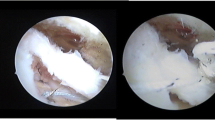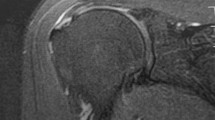Abstract
The purpose of this study was to evaluate the clinical results of rotator cuff tendon tears treated by arthroscopic repair with suture anchors. This prospective study included a cohort of 607 consecutive patients who underwent arthroscopic rotator cuff repair surgery. Most patients had a single-row type of repair using metal anchors. All patients were independently assessed pre- and post-operatively utilizing the UCLA (University of California at Los Angeles) scoring system with a minimum of 1 year follow-up. Demographic and operative details were noted; including the patient age, workers compensation status, tear size, type of repair performed, and concomitant procedures. The median UCLA score improved from 13 (0–28) to 35 (8–35) with a median follow-up time of 46 months (12–105), P < 0.001. The majority of the patients (529) achieved good to excellent results. The results were found to be independent of age, workers compensation status, tear size, type of repair performed and concomitant procedures. In conclusion, arthroscopic rotator cuff repair, using metal anchors with dual sutures, in a single row, utilizing margin convergence sutures and performing concomitant procedures when necessary, gave satisfactory results in 87% of patients.

Similar content being viewed by others
References
Amstutz HC, Sew Hoy AL, Clarke IC (1981) UCLA anatomic total shoulder arthroplasty. Clin Orthop Relat Res 155:7–20
Barber FA, Herbert MA, Richards DP (2003) Sutures and suture anchors: update 2003. Arthroscopy 19:985–990
Bennett WF (2003) Arthroscopic repair of full-thickness supraspinatus tears (small-to-medium): a prospective study with 2- to 4-year follow-up. Arthroscopy 19:249–256
Bishop J, Klepps S, Lo IK, Bird J, Gladstone J, Flatow EL (2006) Cuff integrity following arthroscopic versus open rotator cuff repair: a prospective study. J Shoulder Elbow Surg 15:290–299
Burkhart SS, Barth JR, Richards DP, Zlatkin MB, Larsen M (2007) Arthroscopic repair of massive rotator cuff tears with stage 3 and 4 fatty degeneration. Arthroscopy 23:347–354
Burkhart SS, Danaceau SM, Pearce CE (2001) Arthroscopic rotator cuff repair: analysis of results by tear size and repair technique margin convergence versus direct tendon-to-bone repair. Arthroscopy 17:905–912
Burkhart SS, Tehrany AM (2002) Arthroscopic subscapularis tendon repair: technique and preliminary results. Arthroscopy 18:454–463
Burns JP, Snyder SJ (2008) Arthroscopic rotator cuff repair in patients younger than fifty years of age. J Shoulder Elbow Surg 17:90–96
Codman EA (1990) Rupture of the supraspinatus tendon. Clin Orthop Relat Res 254:3–26
DeFranco MJ, Bershadsky B, Ciccone J, Yum JK, Iannotti JP (2007) Functional outcome of arthroscopic rotator cuff repairs: a correlation of anatomic and clinical results. J Shoulder Elbow Surg 16:759–765
Fealy S, Rodeo SA, MacGillivray JD, Nixon AJ, Adler RS, Warren RF (2006) Biomechanical evaluation of the relation between number of suture anchors and strength of the bone-tendon interface in a goat rotator cuff model. Arthroscopy 22:595–602
Galatz LM, Ball CM, Teefey SA, Middleton WD, Yamaguchi K (2004) The outcome and repair integrity of completely arthroscopically repaired large and massive rotator cuff tears. J Bone Joint Surg Am 86:219–224
Galatz LM, Griggs S, Cameron BD, Iannotti JP (2001) Prospective longitudinal analysis of postoperative shoulder function: a ten-year follow-up study of full-thickness rotator cuff tears. J Bone Surg Am 83:1052–1056
Gartsman GM, Khan M, Hammerman SM (1998) Arthroscopic repair of full thickness tears of the rotator cuff. J Bone Joint Surg Am 80:832–840
Grana WA, Teague B, King M, Reeves RB (1994) An analysis of rotator cuff repair. Am J Sports Med 22:585–588
Grondel RJ, Savoie FH III, Field LD (2001) Rotator cuff repairs in patients 62 years of age or older. J Shoulder Elbow Surg 10:97–99
Ide J, Tokiyoshi A, Hirose J, Mizuta H (2007) Arthroscopic repair of traumatic combined rotator cuff tears involving the subscapularis tendon. J Bone Joint Surg Am 89:2378–2388
Krishnan SG, Harkins DC, Schiffern SC, Pennington SD, Burkhead WZ (2008) Arthroscopic repair of full-thickness tears of the rotator cuff in patients younger than 40 years. Arthroscopy 24:324–328
Lähteenmäki HE, Hiltunen A, Virolainen P, Nelimarkka O (2007) Repair of full-thickness rotator cuff tears is recommended regardless of tear size and age: a retrospective study of 218 patients. J Shoulder Elbow Surg 16:586–590
Lee E, Bishop JY, Braman JP, Langford J, Gelber J, Flatow EL (2007) Outcomes after arthroscopic rotator cuff repairs. J Shoulder Elbow Surg 16:1–5
Misamore GW, Ziegler DW, Rushton JL (1995) Repair of the rotator cuff. A comparison of the results in two populations of patients. J Bone Joint Surg Am 77:1335–1339
Oh JH, Kim SH, Lee HK, Jo KH, Bin SW, Gong HS (2008) Moderate preoperative shoulder stiffness does not alter the clinical outcome of rotator cuff repair with arthroscopic release and manipulation. Arthroscopy 24:983–991
Post M, Silver R, Singh M (1983) Rotator cuff tear. Diagnosis and treatment. Clin Orthop Relat Res 173:78–91
Snyder SJ, Pachelli AF, Del Pizzo W, Friedman MJ, Ferkel RD, Pattee G (1991) Partial thickness rotator cuff tears: results of arthroscopic treatment. Arthroscopy 7:1–7
Tauro JC (1998) Arthroscopic rotator cuff repair: analysis of technique and results at 2- and 3-year follow-up. Arthroscopy 14:45–51
Wolf EM, Pennington WT, Agrawal V (2004) Arthroscopic rotator cuff repair: 4- to 10- year results. Arthroscopy 20:5–12
Wolf EM, Pennington WT, Agrawal V (2005) Arthroscopic side-to-side rotator cuff repair. Arthroscopy 21:881–887
Yamaguchi K, Ditsios K, Middleton WD, Hildebolt CF, Galatz LM, Teefey SA (2006) The demographic and morphological features of rotator cuff disease. A comparison of asymptomatic and symptomatic shoulders. J Bone Joint Surg Am 88:1699–1704
Author information
Authors and Affiliations
Corresponding author
Rights and permissions
About this article
Cite this article
Haviv, B., Dolev, E., Haber, M. et al. Arthroscopic rotator cuff repair: clinical outcome of 607 patients. Knee Surg Sports Traumatol Arthrosc 18, 1707–1711 (2010). https://doi.org/10.1007/s00167-010-1091-7
Received:
Accepted:
Published:
Issue Date:
DOI: https://doi.org/10.1007/s00167-010-1091-7




